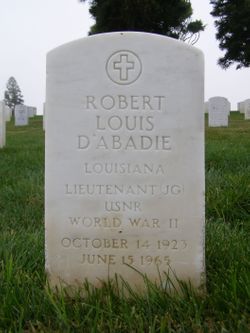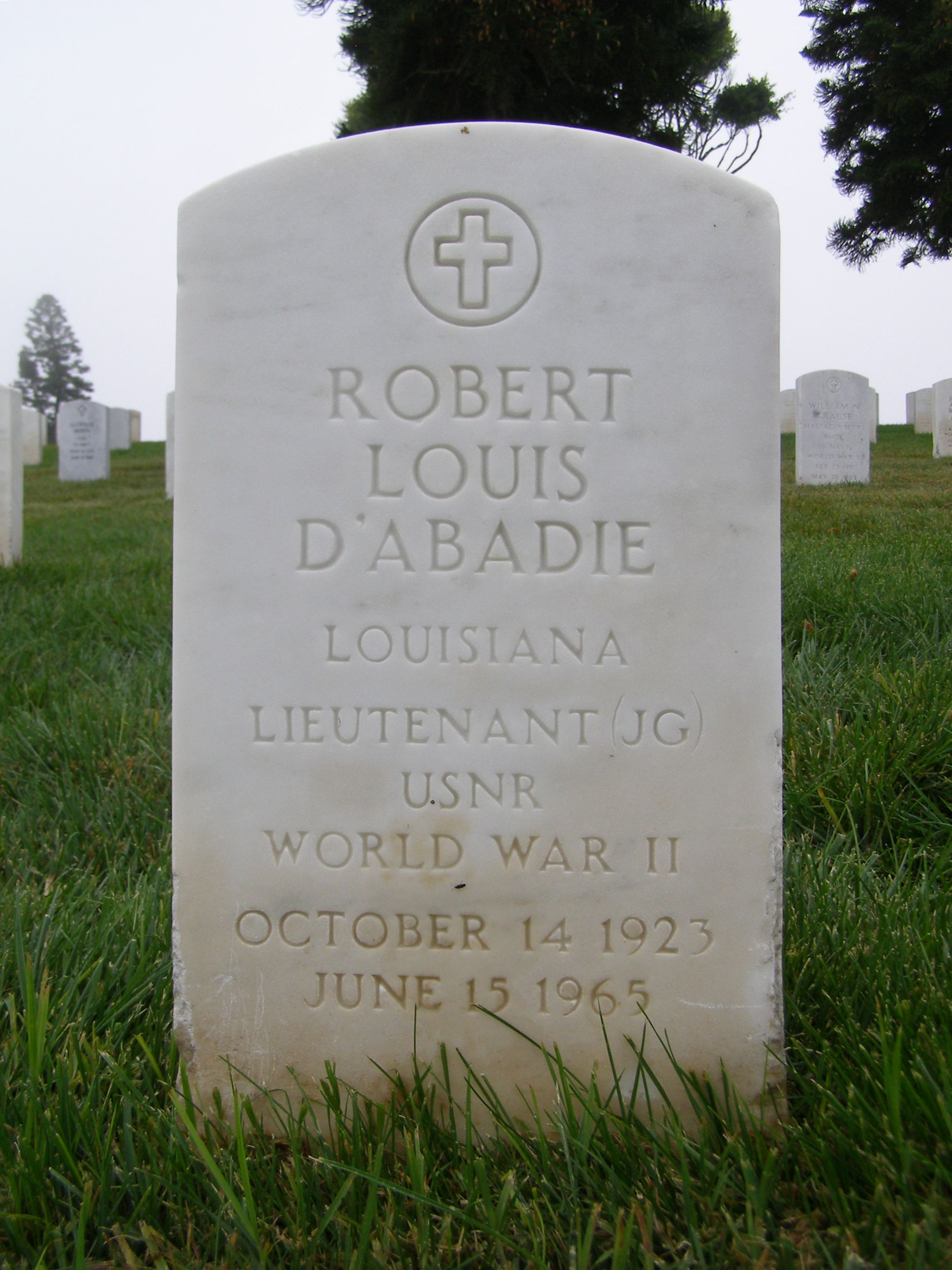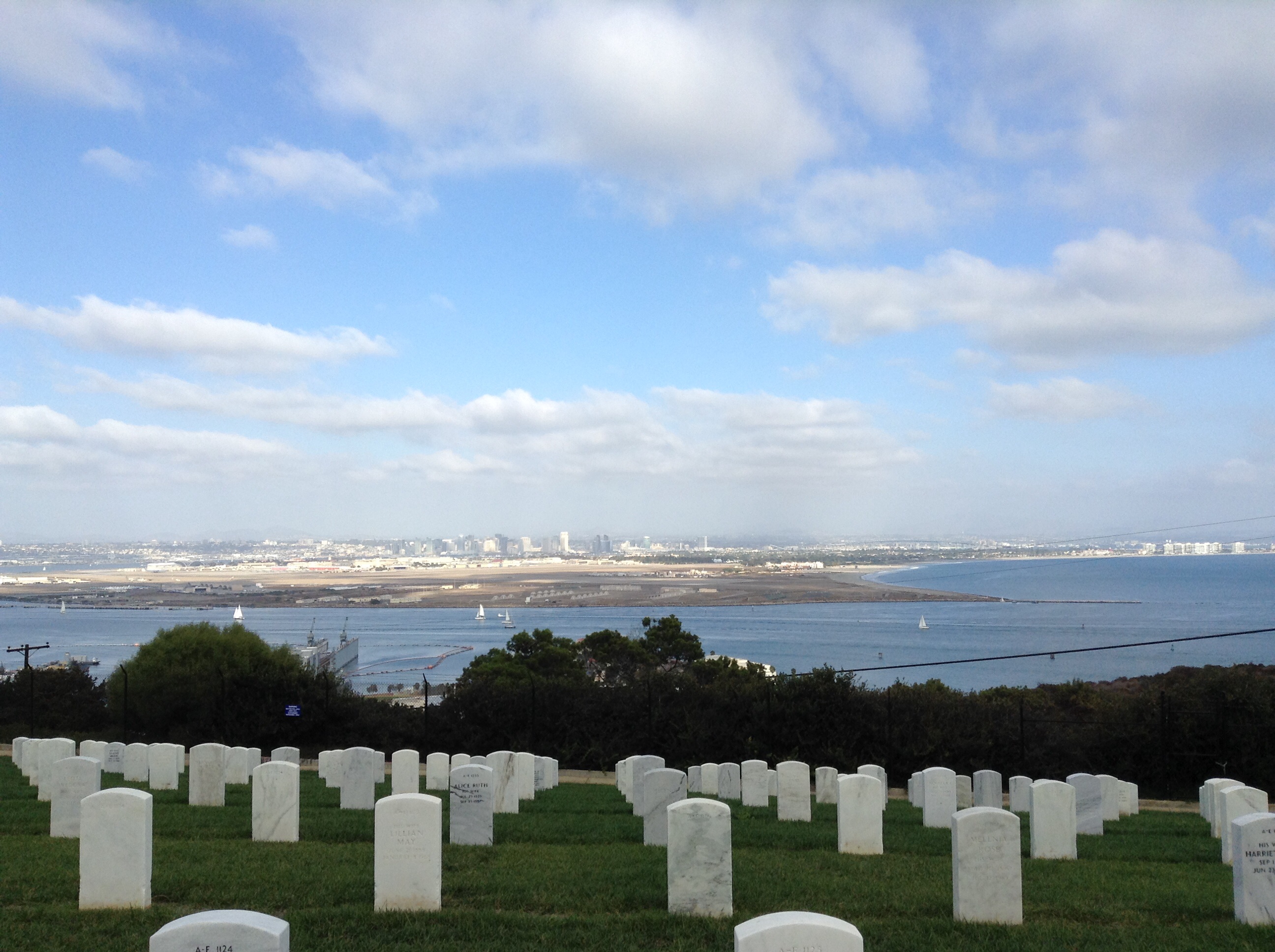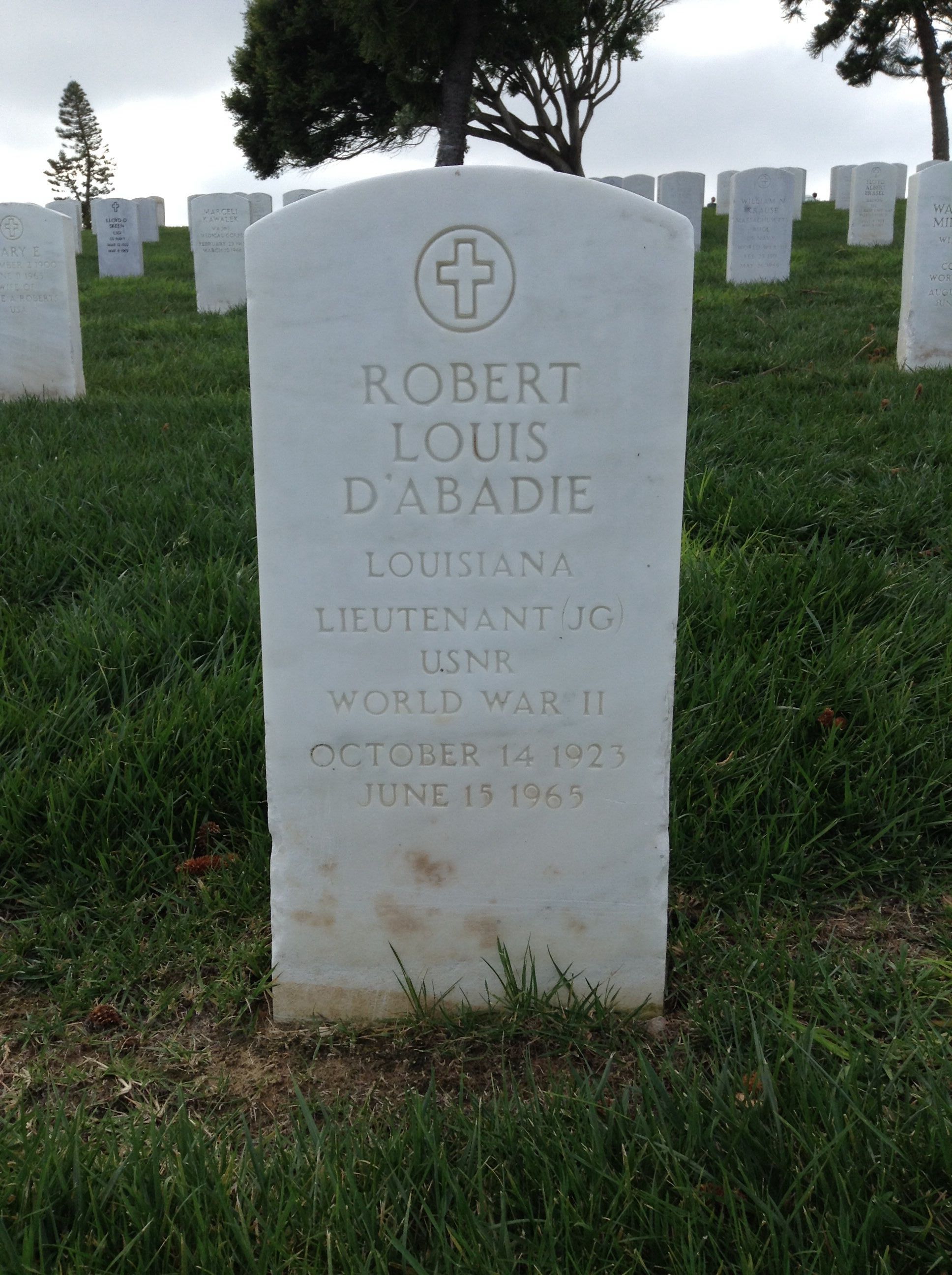Robert Louis D'Abadie was born in Pt Coupee Parish, Louisiana, the son of Felix and Christine Jewell D"Abadie. At a young age Robert and his family moved to the town of Houma, Louisiana.
In December 1943, Robert graduated from Louisiana State University with a Bachelor's Degree in mechanical engineering and a minor in aeronautical engineering, World War II had engulfed all Americans and only those young men who were near finishing a degree in a technical study were exempt from the draft.
Bob's first job was with Boeing Aircraft Co. in Seattle, Wash. He was a technical analyst in the flight test department. At that time Boeing, the builder of the popular B-17 bomber for the Army Air Force, began switching its production to the B-29 which was to be used in the Pacific Theater against Japan.
By May, 1944, no more engineering exemptions from the draft were permitted and all young engineers were allowed to volunteer for their choice of branch in the Armed Forces. Bob chose the Navy and became a "90 Day Wonder," graduating from U.S.S. Beardown at the University of Arizona with the rank of Ensign. He served two years in the Navy as a gunnery officer aboard various Landing Craft,LST and LSI, (Landing ship-tank, Landing ship-infantry) in the Pacific.
After the war, Bob used the G.I.Bill to pursue his Master's Degree in mechanical engineering at LSU. He was also asked to teach classes in mechanical drawing.
Upon the completion of his Master's Degree, Bob traveled to Ft. Worth, Texas and interviewed with Consolidated Vought (Convair). This company manufactured the huge B-36 Peacemaker aircraft. Bob accepted Convair's job offer as an analyst in the Flight Test Department with great excitement. He remained in Ft. Worth for 12 years and worked in the Flight Test Department as the company went through name and organizational changes, eventually becoming General Dynamics. He flew 1000 test hours on the B-36 as a flight test engineer. At one time he helped test a small nuclear power plant and other exotic power plants for the B-36. He helped test the Jet pods that were later added to the B-36 to increase range and pay load capabilities of the aircraft.
A B-36 and crew at Carswell Air Force Base, across the field from Convair, were scheduled to drop a test nuclear bomb in the Marshall Islands in the Pacific Ocean. The pilot, Lt. Col. George J. Savage, was one of Bob's close friends. Bob had suggested that Savage and his crew wax the airplane to help add speed in the turn and flight away from the bomb drop. The drop was made without error and the blackened, smoked plane sat at the end of a runway in Ft. Worth upon return for some time to "cool off".
In the late 1950s, Bob became a Flight Test Supervisor for the B-58, a supersonic bomber. The B-58 was one of a new class of aircraft with computerized weapons systems. It required a crew of two. Bob took one flight in the B-58. He received recognition as one of the first 10 to go supersonic in the plane. He found his reflexes were no longer quick enough, and did not complain when his flying days were over.
The B-58's were sophisticated airplanes. They crashed several times before production models were turned over to the U.S. Air force. The crashes were caused by pilot error, metal fatigue resulting from a design flaw, and a thunderstorm. Four of Bob's flight test engineers were killed in those crashes along with the pilots. Bob felt responsible for his men's deaths as he had assigned them to the fatal flights.
The XF-11 (later the F-111), a swing wing fighter plane, was on the drawing boards. Bob and his men began the master flight testing plan for it. Bob knew he could not endure any more flight test deaths, so in 1960, he left the aircraft field and transferred to the missile division of General Dynamics. 12 Atlas missiles were being installed around Roswell, New Mexico. Bob was a technical specialist on several of the missile sites. His job was engineering and trouble-shooting. At the time of the Cuban missile crisis, President Kennedy had 12 Atlas missiles at Roswell, among others, aimed at Moscow, in case of need. The General Dynamics technical force was able to manually load and position the Atlas missiles during that emergency.
The Atlas missile quickly became obsolete. Bob was transferred to the San Diego plant to design and test missile refinements. Some of his work was carried out at San Bernardino, CA and Vandenberg Air Force Base. During that portion of the Cold War, missile contracts were awarded to various defense companies. Work slowed at General Dynamics and Bob took a job with North American Aviation.
Shortly before his death, Bob was assigned flight test work on the Saturn project which was designed to put a man on the moon. The rocket testing was to be done in a flame bucket on the river near Pascagoula, Mississippi. Before making the move, Bob collapsed and died on June 15, 1965. He was buried at Ft. Rosecrans National Cemetery in San Diego California.
Edited from the notes of Bernice D'Abadie, July 13, 1998
Robert Louis D'Abadie was born in Pt Coupee Parish, Louisiana, the son of Felix and Christine Jewell D"Abadie. At a young age Robert and his family moved to the town of Houma, Louisiana.
In December 1943, Robert graduated from Louisiana State University with a Bachelor's Degree in mechanical engineering and a minor in aeronautical engineering, World War II had engulfed all Americans and only those young men who were near finishing a degree in a technical study were exempt from the draft.
Bob's first job was with Boeing Aircraft Co. in Seattle, Wash. He was a technical analyst in the flight test department. At that time Boeing, the builder of the popular B-17 bomber for the Army Air Force, began switching its production to the B-29 which was to be used in the Pacific Theater against Japan.
By May, 1944, no more engineering exemptions from the draft were permitted and all young engineers were allowed to volunteer for their choice of branch in the Armed Forces. Bob chose the Navy and became a "90 Day Wonder," graduating from U.S.S. Beardown at the University of Arizona with the rank of Ensign. He served two years in the Navy as a gunnery officer aboard various Landing Craft,LST and LSI, (Landing ship-tank, Landing ship-infantry) in the Pacific.
After the war, Bob used the G.I.Bill to pursue his Master's Degree in mechanical engineering at LSU. He was also asked to teach classes in mechanical drawing.
Upon the completion of his Master's Degree, Bob traveled to Ft. Worth, Texas and interviewed with Consolidated Vought (Convair). This company manufactured the huge B-36 Peacemaker aircraft. Bob accepted Convair's job offer as an analyst in the Flight Test Department with great excitement. He remained in Ft. Worth for 12 years and worked in the Flight Test Department as the company went through name and organizational changes, eventually becoming General Dynamics. He flew 1000 test hours on the B-36 as a flight test engineer. At one time he helped test a small nuclear power plant and other exotic power plants for the B-36. He helped test the Jet pods that were later added to the B-36 to increase range and pay load capabilities of the aircraft.
A B-36 and crew at Carswell Air Force Base, across the field from Convair, were scheduled to drop a test nuclear bomb in the Marshall Islands in the Pacific Ocean. The pilot, Lt. Col. George J. Savage, was one of Bob's close friends. Bob had suggested that Savage and his crew wax the airplane to help add speed in the turn and flight away from the bomb drop. The drop was made without error and the blackened, smoked plane sat at the end of a runway in Ft. Worth upon return for some time to "cool off".
In the late 1950s, Bob became a Flight Test Supervisor for the B-58, a supersonic bomber. The B-58 was one of a new class of aircraft with computerized weapons systems. It required a crew of two. Bob took one flight in the B-58. He received recognition as one of the first 10 to go supersonic in the plane. He found his reflexes were no longer quick enough, and did not complain when his flying days were over.
The B-58's were sophisticated airplanes. They crashed several times before production models were turned over to the U.S. Air force. The crashes were caused by pilot error, metal fatigue resulting from a design flaw, and a thunderstorm. Four of Bob's flight test engineers were killed in those crashes along with the pilots. Bob felt responsible for his men's deaths as he had assigned them to the fatal flights.
The XF-11 (later the F-111), a swing wing fighter plane, was on the drawing boards. Bob and his men began the master flight testing plan for it. Bob knew he could not endure any more flight test deaths, so in 1960, he left the aircraft field and transferred to the missile division of General Dynamics. 12 Atlas missiles were being installed around Roswell, New Mexico. Bob was a technical specialist on several of the missile sites. His job was engineering and trouble-shooting. At the time of the Cuban missile crisis, President Kennedy had 12 Atlas missiles at Roswell, among others, aimed at Moscow, in case of need. The General Dynamics technical force was able to manually load and position the Atlas missiles during that emergency.
The Atlas missile quickly became obsolete. Bob was transferred to the San Diego plant to design and test missile refinements. Some of his work was carried out at San Bernardino, CA and Vandenberg Air Force Base. During that portion of the Cold War, missile contracts were awarded to various defense companies. Work slowed at General Dynamics and Bob took a job with North American Aviation.
Shortly before his death, Bob was assigned flight test work on the Saturn project which was designed to put a man on the moon. The rocket testing was to be done in a flame bucket on the river near Pascagoula, Mississippi. Before making the move, Bob collapsed and died on June 15, 1965. He was buried at Ft. Rosecrans National Cemetery in San Diego California.
Edited from the notes of Bernice D'Abadie, July 13, 1998
Inscription
LOUISIANA
LIEUTENANT JG
USNR
WORLD WAR II











